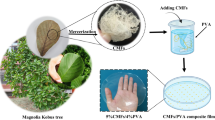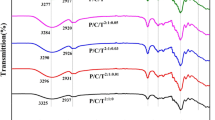Abstract
In this research, microcrystalline celluloses (MCC) extracted from Jerusalem artichoke stalk, Sweet sorghum stalk, Distiller’s grains, and Chinese herb residue were respectively incorporated with poly (vinyl alcohol) (PVA) to prepare the biodegradable composite films for the preservation of Lanzhou lily. The effects of different MCC sources and contents on the physicochemical properties of composite films were investigated. The crosslinking of four kinds of obtained MCCs with PVA could significantly improve the thermal stability and UV–Vis barrier property of PVA film. When the amount of MCC was 5%, the decrease of PVA/CHRMCC composite film was the largest among the four films, which was 30.97%. In the second stage of thermal decomposition, the decomposition temperature of MCC/PVA composite film is lower than that of pure PVA film (233.12 °C). A majority of PVA/MCC composite films have good mechanical properties and flat surface, especially the composite films fabricated with 5% MCC, which was elected for subsequent preservation of lily bulbs. Lily bulbs packaged with PVA/MCC composite films demonstrated enhanced preservation efficacy. This is attributed to the film’s ability to slow down respiration and decrease enzyme activity. Notably, by the end of the 12th day of storage, the PPO activity in lily bulbs wrapped with MCC/PVA was approximately 29% less than that of the control group. This can be ascribed to the film’s capability in inhibiting gas exchange and the accumulation of malondialdehyde. Moreover, PVA/CHRMCC composite film was recommend based on subordinate function method.








Similar content being viewed by others
Data availability
Data will be made available on request.
References
H. Hui, X. Li, H. Jin, X. Yang, A. Xin, R. Zhao, B. Qin, Structural characterization, antioxidant and antibacterial activities of two heteropolysaccharides purified from the bulbs of Lilium davidii var. unicolor cotton. Int. J. Biol. Macromol. 133, 306–315 (2019). https://doi.org/10.1016/j.ijbiomac.2019.04.082
X. Li, W. Gao, Q. Jiang, Y. Xia, Physicochemical, morphological, and thermal properties of starches separated from bulbs of four Chinese lily cultivars. Starch—Stärke. 64(7), 545–551 (2012). https://doi.org/10.1002/star.201100189
E. Lee, N. Yun, Y. Jang, J. Kim, Lilium lancifolium Thunb. extract attenuates pulmonary inflammation and air space enlargement in a cigarette smoke-exposed mouse model. J. Ethnopharmacol. 149(1), 148–156 (2013). https://doi.org/10.1016/j.saa.2020.118837
L. Barbosa-Pereira, I. Angulo, J.M. Lagarón, P. Paseiro-Losada, J.M. Cruz, Development of new active packaging films containing bioactive nanocomposites. Innov. Food Sci. Emerg. Technol. 26, 310–318 (2014). https://doi.org/10.1016/j.ifset.2014.06.002
W. Li, Y. Wang, H. Wei, Y. Zhang, Z. Guo, Y. Qiu, L. Wen, Z. Xie, Structural characterization of Lanzhou lily (Lilium davidiivar, unicolor) polysaccharides and determination of their associated antioxidant activity. J. Sci. Food Agric. 100(15), 5603–5616 (2020). https://doi.org/10.1002/jsfa.10613
H. Ren, Z. Xu, M. Gao, X. Xing, Z. Ling, L. Pan, Y. Tian, Y. Zheng, W. Fan, W. Yang, Preparation of microcrystalline cellulose from agricultural residues and their application as polylactic acid/microcrystalline cellulose composite films for the preservation of Lanzhou lily. Int. J. Biol. Macromol. 227, 827–838 (2023). https://doi.org/10.1016/j.ijbiomac.2022.12.198
X. Zhou, Y. Xiao, X. Meng, B. Liu, Full inhibition of Whangkeumbae pear polyphenol oxidase enzymatic browning reaction by l-cysteine. Food Chem. 266, 1–8 (2018). https://doi.org/10.1016/j.foodchem.2018.05.086
S. Kang, Y. Xiao, X. Guo, A. Huang, H. Xu, Development of gum arabic-based nanocomposite films reinforced with cellulose nanocrystals for strawberry preservation. Food Chem. 350, 129199 (2021). https://doi.org/10.1016/j.foodchem.2021.129199
W. Lan, S. Wang, M. Chen, D. Sameen, K. Lee, Y. Liu, Developing poly (vinyl alcohol)/chitosan films incorporate with d-limonene: study of structural, antibacterial, and fruit preservation properties. Int. J. Biol. Macromol. 145, 722–732 (2020). https://doi.org/10.1016/j.ijbiomac.2019.12.230
R. Bortolatto, P.S. Bittencourt, F. Yamashita, Biodegradable starch/polyvinyl alcohol composites produced by thermoplastic injection containing cellulose extracted from soybean hulls (Glycine max L.). Indus. Crops Prod. 176, 114383 (2022). https://doi.org/10.1016/j.indcrop.2021.114383
Y. Ye, F. Zeng, M. Zhang, S. Zheng, J. Li, P. Fei, Hydrophobic edible composite packaging membrane based on low-methoxyl pectin/chitosan: effects of lotus leaf cutin. Food Packag. Shelf Life 26, 100592 (2020). https://doi.org/10.1016/j.fpsl.2020.100592
X. Sun, C. Lu, Y. Liu, W. Zhang, X. Zhang, Melt-processed poly (vinyl alcohol) composites filled with microcrystalline cellulose from waste cotton fabrics. Carbohyd. Polym. 101, 642–649 (2014). https://doi.org/10.1016/j.carbpol.2013.09.088
A. Alemdar, M. Sain, Biocomposites from wheat straw nanofibers: morphology, thermal and mechanical properties. Compos. Sci. Technol. 68(2), 557–565 (2008). https://doi.org/10.1016/j.compscitech.2007.05.044
K. Das, D. Ray, N.R. Bandyopadhyay, S. Sengupta, Study of the properties of microcrystalline cellulose particles from different renewable resources by XRD, FTIR, nanoindentation, TGA and SEM. J. Polym. Environ. 18(3), 355–363 (2010). https://doi.org/10.1007/s10924-010-0167-2
S. Ventura-Cruz, A. Tecante, Nanocellulose and microcrystalline cellulose from agricultural waste: review on isolation and application as reinforcement in polymeric matrices. Food Hydrocoll. 118(4), 106771 (2021). https://doi.org/10.1016/j.foodhyd.2021.106771
J. Baruah, R.C. Deka, E. Kalita, Greener production of microcrystalline cellulose (MCC) from saccharum spontaneum (kans grass): statistical optimization. Int. J. Biol. Macromol. 154, 672–682 (2020). https://doi.org/10.1016/j.ijbiomac.2020.03.158
M.S. Hasanin, N. Kassem, M.L. Hassan, Preparation and characterization of microcrystalline cellulose from olive stones. Biomass Convers. Biorefin. (2021). https://doi.org/10.1007/s13399-021-01423-y
J. Jiang, L. Gong, Q. Dong, Y. Kang, L. Li, Characterization of PLA-P3, 4HB active film incorporated with essential oil: application in peach preservation. Food Chem. 313, 126134 (2019). https://doi.org/10.1016/j.foodchem.2019.126134
T. Jiang, Effect of alginate coating on physicochemical and sensory qualities of button mushrooms (Agaricus bisporus) under a high oxygen modified atmosphere. Postharvest Biol. Technol. 76, 91–97 (2013). https://doi.org/10.1016/j.postharvbio.2012.09.005
D. Huang, W. Li, M.M. Dawuda, J. Huo, W. Liao, Hydrogen sulfide reduced colour change in Lanzhou lily-bulb scales. Postharvest Biol. Technol. 176, 111520 (2021). https://doi.org/10.1016/j.postharvbio.2021.111520
C. Zhang, Z. Yang, J. Shi, X. Zou, X. Zhai, X. Huang, Z. Li, M. Holmes, M. Daglia, J. Xiao, Physical properties and bioactivities of chitosan/gelatin-based films loaded with tannic acid and its application on the preservation of fresh-cut apples. LWT Food Science and Technology 144, 111223 (2021). https://doi.org/10.1016/j.lwt.2021.111223
C. Liu, Z. Yang, Y. Hu, Drought resistance of wheat alien chromosome addition lines evaluated by membership function value based on multiple traits and drought resistance index of grain yield. Field Crop Res 179, 103–112 (2015). https://doi.org/10.1016/j.fcr.2015.04.016
B. Priya, V.K. Gupta, D. Pathania, A.S. Singha, Synthesis, characterization and antibacterial activity of biodegradable starch/PVA composite films reinforced with cellulosic fibre. Carbohyd. Polym. 109, 171–179 (2014). https://doi.org/10.1016/j.carbpol.2014.03.044
M. Atef, M. Rezaei, R. Behrooz, Preparation and characterization agar-based nanocomposite film reinforced by nanocrystalline cellulose. Int. J. Biol. Macromol. 70, 537–544 (2014). https://doi.org/10.1016/j.ijbiomac.2014.07.013
Q. Chen, Y. Shi, G. Chen, M. Cai, Enhanced mechanical and hydrophobic properties of composite cassava starch films with stearic acid modified MCC (microcrystalline cellulose)/NCC (nanocellulose) as strength agent. Int. J. Biol. Macromol. 142, 846–854 (2020). https://doi.org/10.1016/j.ijbiomac.2019.10.024
R.D. Kale, V.G. Gorade, N. Madye, B. Chaudhary, P.S. Bangde, P.P. Dandekar, Preparation and characterization of biocomposite packaging film from poly (lactic acid) and acylated microcrystalline cellulose using rice bran oil. Int. J. Biol. Macromol. 118, 1090–1102 (2018). https://doi.org/10.1016/j.ijbiomac.2018.06.076
X. Yao, J. Liu, H. Hu, D. Yun, J. Liu, Development and comparison of different polysaccharide/PVA-based active/intelligent packaging films containing red pitaya betacyanins. Food Hydrocoll. 124, 107305 (2021). https://doi.org/10.1016/j.foodhyd.2021.107305
S. Naduparambath, M.P. Sreejith, V. Shaniba, A.K. Balan, T.V. Jinitha, E. Purushothaman, Poly (vinyl alcohol) green composites reinforced with microcrystalline cellulose through sonication. Mater. Today Proc. 5(8), 16411–16417 (2018). https://doi.org/10.1016/j.matpr.2018.05.139
C. López-de-Dicastillo, J.M. Alonso, R. Catalá, R. Gavara, P. Hernández-Muñoz, Improving the antioxidant protection of packaged food by incorporating natural flavonoids into ethylene-vinyl alcohol copolymer (EVOH) films. J. Agric. Food Chem. 58(20), 10958–10964 (2010). https://doi.org/10.1021/jf1022324
M. Jonoobi, A. Khazaeian, P.M. Tahir, S.S. Azry, K. Oksman, Characteristics of cellulose nanofibers isolated from rubberwood and empty fruit bunches of oil palm using chemo-mechanical process. Cellulose 18(4), 1085–1095 (2011). https://doi.org/10.1007/s10570-011-9546-7
O.B. Sogvar, M.K. Saba, A. Emamifar, Aloe vera and ascorbic acid coatings maintain postharvest quality and reduce microbial load of strawberry fruit. Postharvest Biol. Technol. 114, 29–35 (2016). https://doi.org/10.1016/j.postharvbio.2015.11.019
X. Dong, X. Liang, Y. Zhou, K. Bao, Y. Liu, Preparation of polylactic acid/TiO2/GO nano-fibrous films and their preservation effect on green peppers. Int. J. Biol. Macromol. (2021). https://doi.org/10.1016/j.ijbiomac.2021.02.125
W. Oyom, Z. Zhang, Y. Bi, R. Tahergorabi, Application of starch-based coatings incorporated with antimicrobial agents for preservation of fruits and vegetables: a review. Prog. Org. Coat. 166, 106800 (2022). https://doi.org/10.1016/j.porgcoat.2022.106800
R.J.P.P. Pressey, Anions activate the oxidation of indoleacetic acid by peroxidases from tomato and other sources. Plant Physiol. 93(2), 798–804 (1990). https://doi.org/10.1104/pp.93.2.798
S.A. Shehata, T.M. El-Sheikh, M.E. Mohamed, M.A. Saleh, Effect of some pre- and postharvest treatments on browning inhibition in fresh cut lettuce during cold storage. J. Appl. Sci. Res. 8(1), 25–33 (2012)
A.B. Cabezas-Serrano, M.L. Amodio, G. Colelli, Effect of solution pH of cysteine-based pre-treatments to prevent browning of fresh-cut artichokes. Postharvest Biol. Technol. 75, 17–23 (2013). https://doi.org/10.1016/j.postharvbio.2012.07.006
F. Jiang, L. Zhou, W. Zhou, Z. Zhong, K. Yu, J. Xu, L. Zou, W. Liu, Effect of modified atmosphere packaging combined with plant essential oils on preservation of fresh-cut lily bulbs. LWT-Food Sci. Technol. 162, 113513 (2022). https://doi.org/10.1016/j.lwt.2022.113513
H.M. Kang, M.E. Saltveit, Antioxidant capacity of lettuce leaf tissue increases after wounding. J. Agric. Food Chem. 50(26), 7536–7541 (2002). https://doi.org/10.1021/jf020721c
Acknowledgements
This work was financially supported by the National Natural Science Foundation of China (Grant Nos. 51666010, 31960491), Key Project of Natural Science Foundation of Gansu Province (Grant No. 21JR7RA203), Natural Science Foundation of Gansu Province (Grant Nos. 20JR10RA159, 23JRRA826), Intellectual property program of Gansu Province (Grant Nos. 20ZSCQ039 and 21ZSCQ073), Red Willow First-class Discipline (Grant No. 0807J1), and Distinguished Young Cultivation of Lanzhou University of Technology (Grant No. JQ2020).
Author information
Authors and Affiliations
Contributions
Haiwei Ren: Conceptualization, Methodology, Project administration, Writing—review & editing, Funding acquisition. Shiyu Zheng: Software, Investigation, Data curation, Writing—original draft, Formal analysis. Ming Gao: Methodology, Investigation, Data curation. Lichao Pan: Validation, Formal analysis, Resources. Weixia Yang: Formal analysis, Resources, Writing—review & editing. Xueye Xing: Investigation, Data curation, Visualization. Zhe Ling: Structural Analysis, Resources, Supervision. Wenguang Fan: Validation, Supervision. Yaqin Tian: Writing—review & editing, Resources. Yi Zheng: Writing—review & editing.
Corresponding authors
Ethics declarations
Competing interest
The authors declare that they have no known competing financial interests or personal relationships that could have appeared to influence the work reported in this paper.
Additional information
Publisher's Note
Springer Nature remains neutral with regard to jurisdictional claims in published maps and institutional affiliations.
Rights and permissions
Springer Nature or its licensor (e.g. a society or other partner) holds exclusive rights to this article under a publishing agreement with the author(s) or other rightsholder(s); author self-archiving of the accepted manuscript version of this article is solely governed by the terms of such publishing agreement and applicable law.
About this article
Cite this article
Ren, H., Zheng, S., Gao, M. et al. Preparation of poly (vinyl alcohol)/microcrystalline cellulose composite film and its application for the preservation of Lanzhou lily (Lilium davidii var. unicolor). Food Measure 18, 1190–1203 (2024). https://doi.org/10.1007/s11694-023-02229-4
Received:
Accepted:
Published:
Issue Date:
DOI: https://doi.org/10.1007/s11694-023-02229-4




